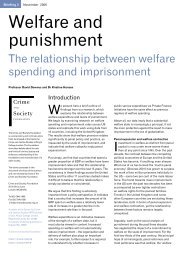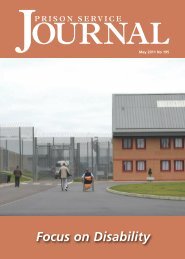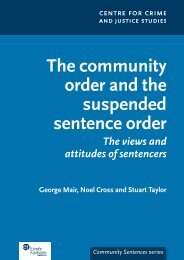PRISON SERVICE
PRISON SERVICE
PRISON SERVICE
- No tags were found...
You also want an ePaper? Increase the reach of your titles
YUMPU automatically turns print PDFs into web optimized ePapers that Google loves.
indicate success and failure in thisrelationship; including those thatremained crime free because of theirfear of custody and those that saidthey returned to crime because ofthe failure of the system to providethe help they needed when theyneeded it.One interesting outcome to theresearch was an unusually longfollow up on re-offending usingcriminal office records. This followup produced surprising results. Only9.6 per cent of the study groupreceived their first new convictionwithin the first year, however thisrose to about one third by year twoand continued to rise to 65.8 percent by the end of 4 years. Thischallenges the conventialassumptions around both rates of reoffendingand desistance. In thissample group it took an average oftwo years to first conviction (forthose that offended) or three yearsof being crime free for the group asa whole. Other studies have shownthat the highest rates of recidivismoccur immediately (i.e. within thefirst 6 months following probationorders). Healy speculates that thismay be as a result of a suddenchange in the economic climate inIreland, although this may equallyraise issues about a relativelyuncharted area of relapse andtemporary desistance. However theauthor then went on to examine thenature of the re-offending to findthat this was composed of relativelyminor offences compared with theindex offence, suggesting that a shifthad in fact taken place that washidden by the fact that reconvictionrates account for all crime and makeno distinction for seriousness.Desistance theory uses this typeof information to add greater depthto the understanding, separatingprimary desistance who are on thepath to true desistance, fromsecondary desisters who we’reexperiencing a lull in offending.Another area which wasstriking was the finding that therewas no significant relationshipbetween criminal cognitions andoffending behaviour, also picked upby other authors and thuschallenging our obsession withtackling criminal thinking throughcognitive based programmes. Againshe found that it was not thatcriminal thinking was not importantbut the style of thinking. Desistersare more likely to externalise blameand not take responsibility as thisenables them to maintain a positiveself image, whereas persisters weremore likely to blame external factorsand personal circumstancesincluding the victim for their crimeand lack of availability of personalresources.Overall the book was wellwritten, accessible and shouldcertainly be of interest topractitioners and students alike.Steve Hall is a prison managercurrently working for SERCO.Book ReviewRelease from Prison. Europeanpolicy and practiceEdited by Nicola Padfield, Dirk vanZyl Smith and Frieder Dunkel.Publisher: Willan Publishing (2010)ISBN: 978-1-84392-741-9(hardback)Price: £55.00 (hardback)Parole and the opportunity tobe released from prison is animportant aspect for the vastmajority of prisoners incarceratedthroughout Europe; with differentcountries having different legalsystems and thus rules. Despite thisvariation there has been littlecomparative research published onthe rules of release across Europe.‘Release from Prison. Europeanpolicy and practice’ is therefore amuch needed encyclopaedia on therules of release of sentencedprisoners across 13 different EUCountries. The rationale for thebook is therefore to fill this gap inthe literature and in addition to lookat other surrounding key themesand issues.To put the anthology incontext, the book opens with anintroductory chapter which setsout layout and contents; but moreimportantly is chapter two, whichexplains the European dimensionto the release of sentencedprisoners. Looking at institutionssuch as the Council of Europe andthe Committee for the Preventionof Torture, in addition tojudgments of the European Courtof Human Rights and Council ofEurope Conventions 1 , chapter twoexplains why we now need to lookat parole from a Europeanperspective. Not only do allprisoners under the EuropeanConvention on Human Rights(Article 5.1) have the right to bereleased at the appropriate time,there is also the more complicatedsituation where a prisoner in oneEuropean Country is required orrequests to serve his sentence inanother European Country.Bearing in mind, the hugevariance between some countries,when such circumstances arise,under which rules of releaseshould the prisoner be subject?Brussels has issued a number ofFramework Directives to try andaddress such issues, with some ofthese affecting parole and release.Of greatest importance is CouncilFramework Decision of November2008, which looks at: ‘mutualrecognition to judgments incriminal matters imposingcustodial sentences or measuresinvolving deprivation of liberty forthe purpose of their enforcementin the European Union’. In1. These include the European Convention on the Supervision of Conditionally Sentenced or Conditionally Released Offenders; theEuropean Convention on the International Validity of Criminal Judgments; and, the Convention on the Transfer of Sentenced Persons.Issue 192 Prison Service Journal61











